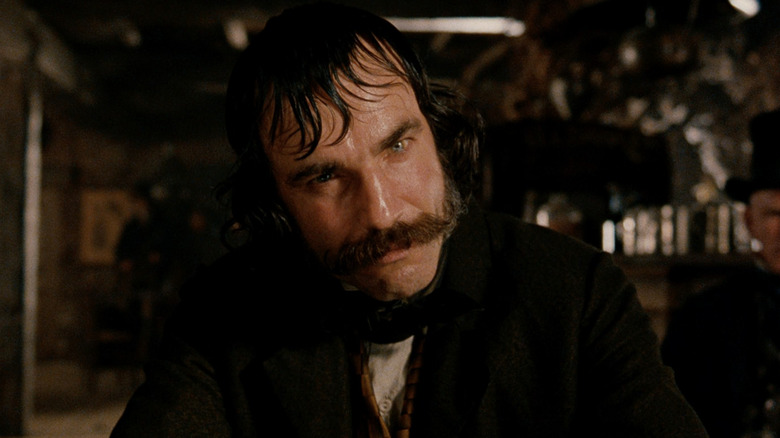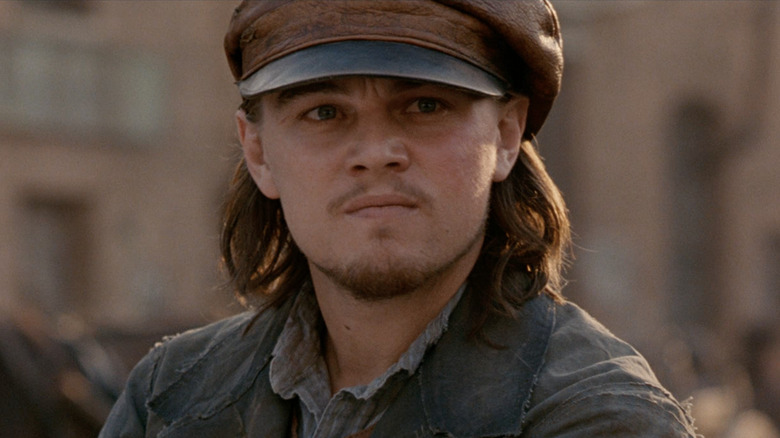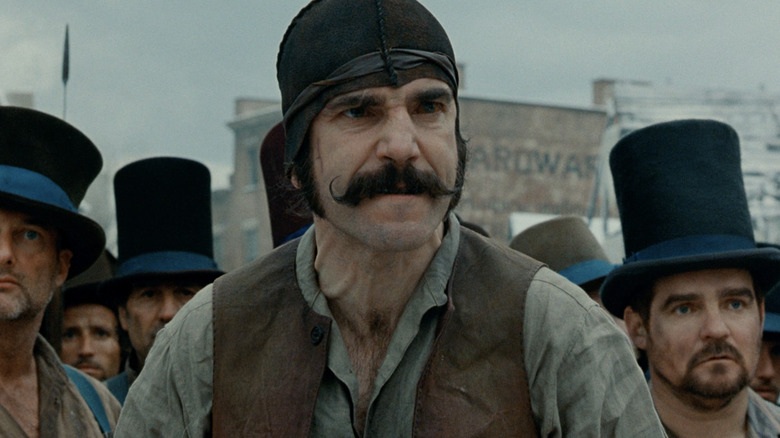Martin Scorsese Made Sure Gangs Of New York Debuted As His Director's Cut
Martin Scorsese has made a number of movies that have cost more, but in my mind, his grandest picture is "Gangs of New York." The 2002 gangster epic about anti-Irish immigrant hatred in Civil War-era New York City contains a bevy of period detail set on a massive scale. Famously, production designer Dante Ferretti built a gigantic set over a mile long that feels like the entire production figured out how to go back in time. The story contains so many groups, dozens of different gangs of political factions, that the world feels endless. The film runs close to three hours and never feels like it sags for a moment, perfectly condensing something that could be a 12-hour miniseries into its most potent form.
"Gangs of New York" had an enormously rocky time finally getting to the silver screen. It was originally planned to come out in the fall of 2001. It was so certain it was featured on the cover of Entertainment Weekly's fall movie preview issue that year. Scorsese and producer Harvey Weinstein entered into a yearslong battle in post-production to get to a final cut. Weinstein, whose criminal sex act and rape convictions were recently upheld by a New York appellate court, was also infamous for meddling heavily in the edits of the movies he produced. Even with a director at the legendary stature of Scorsese, working with the equally lauded editor Thelma Schoonmaker, Weinstein could not help but stick his nose in it. So what was planned for fall 2001 ended up being released on December 20, 2002.
When it was all said and done, the final cut was not some Weinstein-destroyed piece (like with Wong Kar-wai's "The Grandmaster"). "Gangs of New York" was the movie Scorsese wanted it to be.
The value of test screenings
With films of this budget level, test screenings are naturally going to be a part of the post-production process. Filmmakers have wildly varied opinions on the value of the screenings, but ultimately, putting a film in front of an audience is the goal. So bringing in some people to test how the film is playing seems like a pretty sound idea. For "Gangs of New York," Scorsese and Schoomaker were wrestling with a massive epic that someone can easily get lost in the weeds with. The film's world can quickly become second nature to the creatives that they take for granted what information they convey to the audience. Clarity is key, and using feedback from test audiences was instrumental in how they arrived at a cut they liked. Speaking with the late, great Roger Ebert, Scorsese said of the editing process:
"The debate was about how you get a picture to play, not about how long it was ... This is a film that needed to be screened that way because it contains a lot of information. How much was getting across? How much wasn't getting across? How much was getting across that you didn't need to get across, because you could just drop or forget it?"
Versions ranged from being 15 minutes shorter to a full hour longer than the final film. Each contained its own issues. Chopping it down to the barest essentials, as Weinstein was prone to do, does not automatically make for the best experience. Only someone outside of the bubble of the editing room can truly tell you that, and Scorsese wanted to hear those voices.
Pacing is everything
Whenever I see someone bemoan a film for having a long running time or celebrate when something is under 90 minutes, part of me wants to scream. If a film hovers around the three-hour mark, it somehow has to "justify" why it is that long. Justify with what exactly, I'm not sure. Do they need added spectacle, or something? They just need to feel like they are getting their money's worth if they make the time commitment.
Here's the thing: No one running time is superior to another. A film should be however long it needs to be. It all comes down to structure and pacing. If a film has an assured rhythm to it, you will not feel the length of the film, no matter how long it is. If a film is sloppily put together, it will feel interminable. While Martin Scorsese was cutting "Gangs of New York," he was constantly removing from and adding things into the film until he arrived at the proper pace, telling Roger Ebert:
"I added three or four minutes, clarified certain other things. The rhythm was still off, I felt. This went on and on over a period of about a year. At one point I put too much back in."
Filmmaking takes constant trial and error. It is not an exact science. Sometimes, filmmakers just need time to experiment with the materials at their disposal until they come up with a concoction that finally feels right. This is why I am not in favor of planning a release date for a film before even having a script. Finding the right rhythm could be immediate or take months. Thankfully, Scorsese had the power on "Gangs of New York" to delay the film's release until he did.


